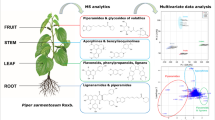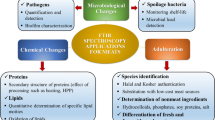Abstract
The fingerprinting method is generally performed to determine specific molecules or the behavior of specific molecular bonds in the desired sample content. A novel, robust and simple method based on surface enhanced Raman spectroscopy (SERS) was developed to obtain the full spectrum of tea varieties for detection of the purity of the samples based on the type of processing and cultivation. For this purpose, the fingerprint of seven different varieties of tea samples (herbal tea (rose hip, chamomile, linden, green and sage tea), black tea and earl grey tea) combined with silver colloids was obtained by SERS in the range of 200–2000 cm−1 with an analysis time of 20 s. Each of the thirty-nine tea samples tested showed its own specific SERS spectra. Principal Component Analysis (PCA) was also applied to separate of each tea variety and different models developed for tea samples including three different models for the herbal teas and two different models for black and earl grey tea samples. Herbal tea samples were separated using mean centering, smoothing and median centering pre-processing steps while baselining and derivatisation pre-processing steps were applied to SERS data of black and earl grey tea. The novel spectroscopic fingerprinting technique combined with PCA is an accurate, rapid and simple methodology for the assessment of tea types based on the type of processing and cultivation differences. This method is proposed as an alternative tool in order to determine the characteristics of tea varieties.





Similar content being viewed by others
References
Alaerts G, Van Erps J, Pieters S, Dumarey M, van Nederkassel AM, Goodarzi M, Vander Heyden Y (2012) Similarity analyses of chromatographic fingerprints as tools for identification and quality control of green tea. J Chromatogr B 910:61–70. doi:10.1016/j.jchromb.2012.04.031
Ananingsih VK, Sharma A, Zhou W (2013) Green tea catechins during food processing and storage: a review on stability and detection. Food Res Int 50:469–479. doi:10.1016/j.foodres.2011.03.004
Chen HX, Zhang M, Qu ZS, Xie BJ (2007) Compositional analysis and preliminary toxicological evaluation of a tea polysaccharide conjugate. J Agric Food Chem 55:2256–2260. doi:10.1021/jf0632740
Cialla D, Marz A, Bohme R, Theil F, Weber K, Schmitt M, Popp J (2012) Surface-enhanced Raman spectroscopy (SERS): progress and trends. Anal Bioanal Chem 403:27–54. doi:10.1007/s00216-011-5631-x
Dejaegher, B., Heyden, Y. V. (2013) Chromatographic Development, Validation and Data Handling of Tea Fingerprints. In:V. R. Preedy (Ed.) Tea in Health and Disease Prevention Elsevier, Amsterdam, pp 323–333. doi:10.1016/B978-0-12-384937-3.00027-6
Deng J, Yang Y (2013) Chemical fingerprint analysis for quality assessment and control of bansha herbal tea using paper spray mass spectrometry. Anal Chim Acta 785:82–90. doi:10.1016/j.aca.2013.04.056
Di Anibal CV, Ruisánchez I, Callao MP (2011) High-resolution 1 H nuclear magnetic resonance spectrometry combined with chemometric treatment to identify adulteration of culinary spices with Sudan dyes. Food Chem 124:1139–1145. doi:10.1016/j.foodchem.2010.07.025
Dumarey M, van Nederkassel AM, Deconinck E, Vander Heyden Y (2008) Exploration of linear multivariate calibration techniques to predict the total antioxidant capacity of green tea from chromatographic fingerprints. J Chromatogr A 1192:81–88. doi:10.1016/j.chroma.2008.03.052
Ferruzzi MG, Green RJ (2006) Analysis of catechins from milk-tea beverages by enzyme assisted extraction followed by high performance liquid chromatography. Food Chem 99:484–491. doi:10.1016/j.foodchem.2005.08.010
Finsterer J (2002) Earl grey tea intoxication. Lancet 359:1484–1484. doi:10.1016/S0140-6736(02)08436-2
Fraser K, Harrison SJ, Lane GA, Otter DE, Hemar Y, Quek S-Y, Rasmussen S (2012) HPLC–MS/MS profiling of proanthocyanidins in teas: a comparative study. J Food Compos Anal 26:43–51. doi:10.1016/j.jfca.2012.01.004
Fraser K, Lane GA, Otter DE, Harrison SJ, Quek S-Y, Hemar Y, Rasmussen S (2013) Monitoring tea fermentation/manufacturing by direct analysis in real time (DART) mass spectrometry. Food Chem 141:2060–2065. doi:10.1016/j.foodchem.2013.05.054
Guven B, Boyaci IH, Tamer U, Calik P (2012) A rapid method for detection of genetically modified organisms based on magnetic separation and surface-enhanced Raman scattering. Analyst 137:202–208. doi:10.1039/c1an15629b
Horžić D, Komes D, Belščak A, Ganić KK, Iveković D, Karlović D (2009) The composition of polyphenols and methylxanthines in teas and herbal infusions. Food Chem 115:441–448. doi:10.1016/j.foodchem.2008.12.022
Kim Y, Goodner KL, Park JD, Choi J, Talcott ST (2011) Changes in antioxidant phytochemicals and volatile composition of Camellia sinensis by oxidation during tea fermentation. Food Chem 129:1331–1342. doi:10.1016/j.foodchem.2011.05.012
Kneipp K, Kneipp H, Itzkan I, Dasari RR, Feld MS (1999) Surface-enhanced non-linear Raman scattering at the single-molecule level. Chem Phys 247:155–162. doi:10.1016/S0301-0104(99)00165-2
Leopold N, Lendl B (2003) A new method for fast preparation of highly surface-enhanced Raman scattering (SERS) active silver colloids at room temperature by reduction of silver nitrate with hydroxylamine hydrochloride. J Phys Chem B 107:5723–5727. doi:10.1021/jp027460u
Lin J, Zhang P, Pan Z, Xu H, Luo Y, Wang X (2013) Discrimination of oolong tea (Camellia sinensis) varieties based on feature extraction and selection from aromatic profiles analysed by HS-SPME/GC–MS. Food Chem 141:259–265. doi:10.1016/j.foodchem.2013.02.128
Liu P, Liu R, Guan G, Jiang C, Wang S, Zhang Z (2011) Surface-enhanced Raman scattering sensor for theophylline determination by molecular imprinting on silver nanoparticles. Analyst 136:4152–4158. doi:10.1039/C1AN15318H
Ma T, Huang C, Meng X, Zhang Q, Zhang L, Lv X, Li J (2011) Fingerprint analysis of hawk-tea by high-performance liquid chromatography. Food Chem 129:551–556. doi:10.1016/j.foodchem.2011.04.059
McNay G, Eustace D, Smith WE, Faulds K, Graham D (2011) Surface-enhanced Raman scattering (SERS) and surface-enhanced resonance Raman scattering (SERRS): a review of applications. Appl Spectrosc 65:825–837. doi:10.1366/11-06365
Nie SP, Xie MY (2011) A review on the isolation and structure of tea polysaccharides and their bioactivities. Food Hydrocoll 25:144–149. doi:10.1016/j.foodhyd.2010.04.010
Orth AM, Yu L, Engel KH (2013) Assessment of dietary exposure to flavouring substances via consumption of flavoured teas. Part 1: occurrence and contents of monoterpenes in earl grey teas marketed in the European Union. Food Addit Contam: Part A 30:1701–1714. doi:10.1080/19440049.2013.817687
Panarin AY, Terekhov SN, Kholostov KI, Bondarenko VP (2010) SERS-active substrates based on n-type porous silicon. Appl Surf Sci 256:6969–6976. doi:10.1016/j.apsusc.2010.05.008
Sang S, Lambert JD, Ho CT, Yang CS (2011) The chemistry and biotransformation of tea constituents. Pharmacol Res 64:87–99. doi:10.1016/j.phrs.2011.02.007
Temiz HT, Boyaci IH, Grabchev I, Tamer U (2013) Surface enhanced Raman spectroscopy as a new spectral technique for quantitative detection of metal ions. Spectrochim Acta A Mol Biomol Spectrosc 116:339–347. doi:10.1016/j.saa.2013.07.071
Temur E, Zengin A, Boyacı IH, Dudak FC, Torul H, Tamer U (2012) Attomole sensitivity of staphylococcal enterotoxin B detection using an aptamer-modified surface-enhanced Raman scattering probe. Anal Chem 84:10600–10606. doi:10.1021/ac301924f
Tistaert C, Dejaegher B, Heyden YV (2011) Chromatographic separation techniques and data handling methods for herbal fingerprints: a review. Anal Chim Acta 690:148–161. doi:10.1016/j.aca.2011.02.023
Uysal RS, Boyaci IH, Genis HE, Tamer U (2013) Determination of butter adulteration with margarine using Raman spectroscopy. Food Chem 141:4397–4403. doi:10.1016/j.foodchem.2013.06.061
Workman Jr, J. (2001) Review of Interpretive Spectroscopy for Raman and Infrared. In: J. Workman (Ed.), The Handbook of Organic Compounds Burlington pp 211–228. doi:10.1016/B978-012763560-6/50037-4
Wu D, Yang H, Chen X, He Y, Li X (2008) Application of image texture for the sorting of tea categories using multi-spectral imaging technique and support vector machine. J Food Eng 88:474–483. doi:10.1016/j.jfoodeng.2008.03.005
Yao L, Jiang Y, Datta N, Singanusong R, Liu X, Duan J, Xu Y (2004) HPLC analyses of flavanols and phenolic acids in the fresh young shoots of tea (Camellia sinensis) grown in Australia. Food Chem 84:253–263. doi:10.1016/S0308-8146(03)00209-7
Yao C, Cheng F, Wang C, Wang Y, Guo X, Gong Z, Zhang Z (2013) Separation, identification and fast determination of organophosphate pesticide methidathion in tea leaves by thin layer chromatography-surface-enhanced Raman scattering. Anal Methods 5:5560–5564. doi:10.1039/C3AY41152D
Yazgan N, Boyaci I, Topcu A, Tamer U (2012) Detection of melamine in milk by surface-enhanced Raman spectroscopy coupled with magnetic and Raman-labeled nanoparticles. Anal Bioanal Chem 403:2009–2017. doi:10.1007/s00216-012-5971-1
Zhang Y, Li Q, Xing H, Lu X, Zhao L, Qu K, Bi K (2013) Evaluation of antioxidant activity of ten compounds in different tea samples by means of an on-line HPLC–DPPH assay. Food Res Int 53:847–856. doi:10.1016/j.foodres.2013.03.026
Zhu QY, Hackman RM, Ensunsa JL, Holt RR, Keen CL (2002) Antioxidative activities of oolong tea. J Agric Food Chem 50:6929–6934. doi:10.1021/jf0206163
Zhu Y, Dluhy RA, Zhao Y (2011) Development of silver nanorod array based fiber optic probes for SERS detection. Sensors Actuators B Chem 157:42–50. doi:10.1016/j.snb.2011.03.024
Zuo YG, Chen H, Deng YW (2002) Simultaneous determination of catechins, caffeine and Gallic acids in green, oolong, black and pu-erh teas using HPLC with a photodiode array detector. Talanta 57:307–316. doi:10.1016/S0039-9140(02)00030-9
Author information
Authors and Affiliations
Corresponding author
Ethics declarations
This article does not contain any studies employing human or animal subjects.
Conflict of ınterest
The authors declare that they have no conflicts of interest.
Additional information
Highlights • Spectral measurements are performed in order to obtain tea fingerprints with SERS. Silver colloids are used to provide signal enhancement. • The PCA tool is used to discriminate seven tea kinds (black, earl grey, linden, chamomile, rose hip, sage, and green tea).
• Leading tea adulteration since fingerprints of types of tea are successfully separated from each other.
Electronic Supplementary Material
ESM 1
(DOC 1511 kb)
Rights and permissions
About this article
Cite this article
Buyukgoz, G.G., Soforoglu, M., Basaran Akgul, N. et al. Spectroscopic fingerprint of tea varieties by surface enhanced Raman spectroscopy. J Food Sci Technol 53, 1709–1716 (2016). https://doi.org/10.1007/s13197-015-2088-5
Revised:
Accepted:
Published:
Issue Date:
DOI: https://doi.org/10.1007/s13197-015-2088-5




